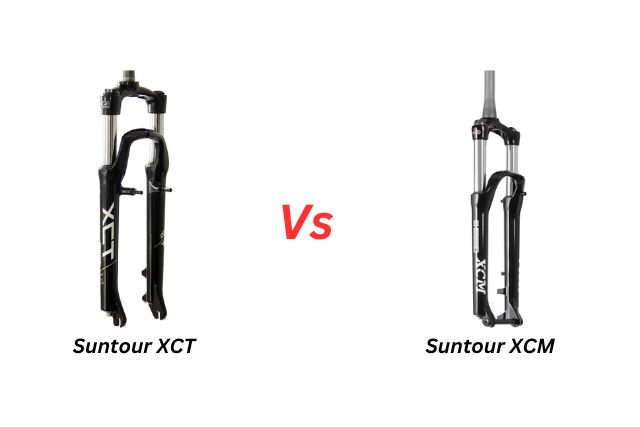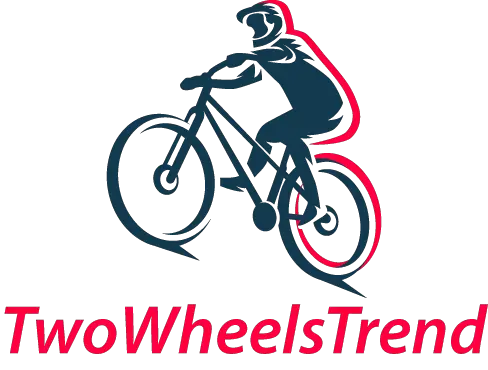
The Suntour XCT and XCM are two of the most popular and affordable forks from Suntour, a Taiwanese company that specializes in bicycle components. But what are the main differences between them, and which one is better suited for your riding style and budget?
Here, we will compare the Suntour XCT and XCM forks in terms of their features, performance, pros and cons, and price.
Features
The Suntour XCT and XCM forks share some common features, such as:
Coil spring system
Both forks use a coil spring to provide suspension. This is a simple and reliable system that does not require much maintenance, but it also adds weight and is not very adjustable.
80-100 mm travel
They offer a range of travel options from 80 to 100 mm, depending on the model. Travel is the amount of vertical movement that the fork can absorb when hitting bumps or obstacles. The more travel, the more comfort and control you have on rough terrain, but also the more weight and flex you have to deal with.
26-29 inch wheel size
These forks can accommodate different wheel sizes, from 26 to 29 inches, depending on the model. Wheel size affects the handling and speed of your bike, as well as the compatibility with your frame and tires.
Disc brake mount
Both forks have a disc brake mount that allows you to install disc brakes on your bike. Disc brakes offer better stopping power and modulation than rim brakes, especially in wet or muddy conditions.
Related: Fox 36 Performance vs. Factory: Compared
Differences between Suntour XCT and Suntour XCM
There are also some significant differences between the Suntour XCT and XCM forks, such as:
Stanchion Diameter
The stanchions are the upper tubes of the fork that slide into the lower legs. The diameter of the stanchions affects the stiffness and strength of the fork. The Suntour XCT has 28 mm stanchions, while the XCM has 30 mm stanchions. This means that the XCM is slightly stiffer and stronger than the XCT, but also heavier.
Lower Leg Material
The lower legs are the part of the fork that connects to the axle and holds the brake mount. The material of the lower legs affects the weight and durability of the fork.
The Suntour XCT has steel lower legs, whereas the XCM has alloy lower legs. The XCM boasts a lighter weight and higher corrosion resistance compared to the XCT. However, it comes with a higher price tag.
Lockout Feature
The lockout feature allows you to lock out or disable the suspension of the fork when you don’t need it, such as on smooth or uphill sections. This can improve your pedaling efficiency and reduce bobbing or bouncing of the fork.
The Suntour XCT has a mechanical lockout feature, while the XCM has a hydraulic lockout feature. The XCM offers a smoother and more precise lockout mechanism in contrast to the XCT, But it is also more intricate and susceptible to potential malfunctions.
Related: Fox Performance vs. Performance Elite: A Detailed Comparison
Performance
The performance of the Suntour XCT and XCM forks depends largely on your riding style, terrain, and expectations.
Neither fork is designed for aggressive or technical riding, such as downhill or enduro. They are best suited for casual or recreational riding on smooth or moderate trails, such as fire roads or bike paths.
Suntour XCT
The Suntour XCT is a basic fork that offers minimal suspension and comfort. It is not very responsive or smooth, and it tends to bottom out or top out easily when hitting bigger bumps or drops. It also flexes a lot under braking or cornering, which can affect your stability and control. However, it is also very cheap and easy to install and maintain.
Suntour XCM
The Suntour XCM is a slightly better fork that offers more suspension and comfort. It is more responsive and smooth than the XCT, and it can handle small to medium bumps or drops better. It also flexes less under braking or cornering, which can improve your stability and control. However, it is also more expensive and heavier than the XCT.
Pros and Cons: Suntour XCT
The Suntour XCT has some pros and cons that you should consider before buying it:
Pros
- Very cheap
- Easy to install and maintain
- Compatible with different wheel sizes
- Has a disc brake mount
- Has a mechanical lockout feature
Cons
- Heavy
- Not very adjustable
- Not very responsive or smooth
- Flexes a lot
- Prone to bottoming out or topping out
Related: Dvo Onyx D1 vs. Fox 36: Compared
Pros and Cons: Suntour XCM
The Suntour XCM has some pros and cons that you should consider before buying it:
Pros
- Affordable
- Lighter than the XCT
- More adjustable than the XCT
- More responsive or smooth than the XCT
- Stiffer than the XCT
- Has a disc brake mount
- Has a hydraulic lockout feature
Cons
- More expensive than the XCT
- Heavier than other forks in its category
- Not very responsive or smooth compared to higher-end forks
- Still flexes under stress
- Prone to failure of the hydraulic lockout mechanism
Price
The price of the Suntour XCT and XCM forks varies depending on the model, travel, wheel size, and seller. Though, in general, the XCT is cheaper than the XCM.
You can find the XCT for around $40-$60, while the XCM can cost around $60-$100. Of course, these prices are subject to change and availability, so you should always check the current market prices before buying.
Related: Marzocchi Bomber Z2 vs. Fox 34: Which One Is Better?
Conclusion
The Suntour XCT and XCM are two entry-level suspension forks that offer basic suspension and comfort for casual or recreational riding. They are not suitable for aggressive or technical riding, as they lack the responsiveness, smoothness, and durability that such riding requires.
Yet, they can be a good option for beginners or budget-conscious riders who want to upgrade their rigid forks or replace their broken forks.
